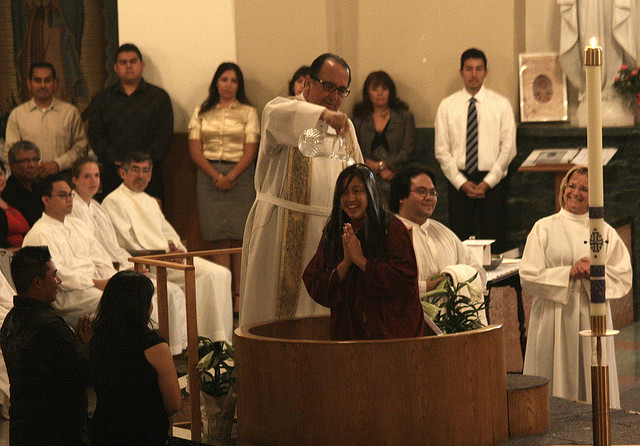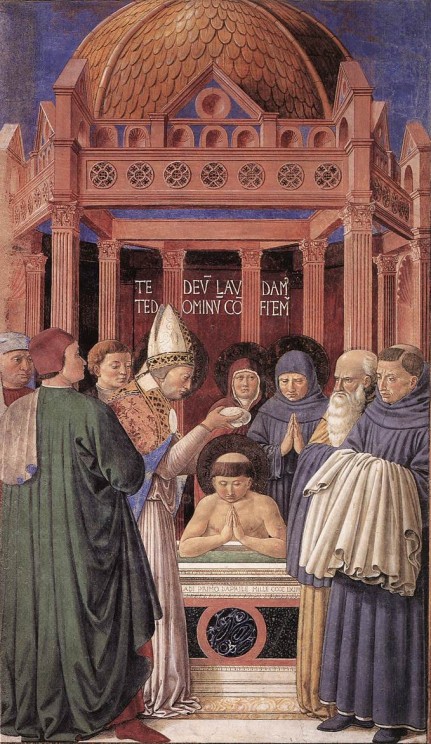By David Yamane
The American religious landscape is ever changing. The rise of religious nones, the spiritual not religious, thoughtful spirituality, the emerging church, online religion, megachurches, and on and on.
As a sociologist of religion who specializes in Roman Catholicism, it is easy to feel old-fashioned in the face of so much novelty. But in its typically deliberate way, the original megachurch in America continues to make its mark on the religious landscape.

Easter Vigil Baptism, April 11, 2009. Image Credit: Photo by IC MONROVIA RCIA, CC 2.0 via Flickr.
On Saturday night, April 19th, at Easter Vigil Masses in most of the 17,000+ parishes in the United States, tens of thousands of individuals will join the Catholic Church. On average over the past ten years, 67,000 adults annually have been baptized Catholic and 83,000 baptized Christians annually have been “Received into Full Communion” with the Roman Catholic church in the United States.
To put these numbers in perspective, these 1.5 million people becoming Catholic over the past decade in themselves would comprise one of the 20 largest religious bodies in America. Catholic converts collectively are about 11% of all Catholics in the United States today. These 5.85 million individuals would be the fifth largest religious body in America, just ahead of the Church of God in Christ and behind the Church of Jesus Christ of Latter Day Saints (the Mormon Church).
These numbers are impressive, but even more notable is that most adults who become Catholic in America today do so through an elaborate initiation process that is both ancient and modern: the Rite of Christian Initiation of Adults (RCIA).

Baptism of St Augustine, public domain via Wikimedia Commons.
In the ancient church, adult baptism was preceded by a structured period of instruction (“catechesis”), which could last as long as three years. Individuals undergoing instruction were called “catechumens” (“hearers of the word”) and the period of instruction was called the “catechumenate.” The process also called for a number of pre-baptismal rites associated with purification and exorcism in preparation for initiation.
As the church’s attention shifted to infant baptism, these rich traditions of adult initiation fell by the wayside. By the mid-20th century in the United States, the process of adult initiation was brief, private, and focused on doctrinal instruction. But the church would soon “modernize” the process of adult initiation, not by looking to the future, but by looking to the past.
French theologians call this ressourcement – looking to the ancient church for models of liturgy and practice to be implemented in the contemporary church. In this way, the church uses tradition to renew tradition. This is exemplified by the call to restore the ancient catechumenate for adults in the Second Vatican Council’s 1963 Constitution on the Sacred Liturgy (Sacrosanctum Concilium, nos. 64-66).
That call led to the publication in 1972 of a new book of rites for adult initiation, in Latin of course, called Ordo Initiationis Christianae Adultorum (the Latin editio typica or “typical edition”). A provisional English translation of this new “order of initiation” was introduced into the Catholic Church in the United States in 1974 and the final official American English translation of the Rite of Christian Initiation of Adults (the “vernacular typical edition”) was published in 1988. At that time, the National Conference of Catholic Bishops also issued guidelines for and mandated the use of the new process.
Like the ancient model, the modern RCIA takes individuals through distinct periods of formation with public ritual transitions that move individuals from one period to the next. The process can take anywhere from months to years to complete. (Tomorrow, I will discuss in greater detail the nuts and bolts of the process.)
Since it was mandated in 1988, at least two million adults have been initiated into the Catholic Church through the RCIA process. But the Catholic Church does not only make its mark on the American religious landscape numerically. The RCIA has also become an influential model of initiation for other Christian traditions. Among the denominations that have implemented a catechumenal process of initiation are the Episcopal Church USA, Evangelical Lutheran Church in America, and the Mennonite Church USA. In 1995, the North American Association for the Catechumenate was founded as an ecumenical group to support and promote the catechumenal process of initiation outside the Catholic Church. Denominational partners include the Anglican Church of Canada, Evangelical Lutheran Church in Canada, Presbyterian Church (USA), Reformed Church in America, and the United Methodist Church.
The influence of the RCIA both inside and outside the Catholic Church suggests that it is one of the most fruitful — if one of the least recognized — legacies of the Second Vatican Council.
David Yamane teaches sociology at Wake Forest University and is author of Becoming Catholic: Finding Rome in the American Religious Landscape. He is currently exploring the phenomenon of armed citizenship in America as part of what has been called “Gun Culture 2.0″ — a new group of individuals (including an increasing number of women) who have entered American gun culture through concealed carry and the shooting sports. He blogs about this at Gun Culture 2.0. Follow him on Twitter @gunculture2pt0.
Subscribe to the OUPblog via email or RSS.
Subscribe to only religion articles on the OUPblog via email or RSS.
The post Initiation into America’s original megachurch appeared first on OUPblog.



